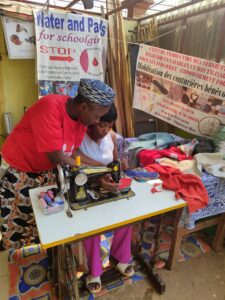 IAW Written Statement to CSW61 2017
IAW Written Statement to CSW61 2017
Inclusive and sustainable growth around the world is the overarching vision of the 2030 development agenda. Gender Equality and Women’s Economic Empowerment are central to this vision but progress has been far too slow.
What is the reason for this lack of progress? The early twenty first century’s global context with rising inequalities, poverty, hunger, climate change all of which are the result of prevailing economic models and paradigms pose unprecedented challenges for the realization of women’s rights and undermine further the sustainability of communities and societies. Dominant development patterns are based on gender inequalities, and have proved unsustainable as regards many issues including economic growth and work.
The underlying causes and consequences of unsustainability are deeply interwined and rooted in the dominant economic models. These involve economic liberalization, the concentration of the productive and financial activity to short term profits, and the privatization of public goods and services, all at the expense of state regulation and redistribution. The fruits of economic growth have also been unequally divided. Over the past three decades economic disparities between and within countries and regions have increased.
What has been the impact of these development patterns on women and work? Women have entered the labor market in large numbers. Free trade and the rapid expansion of market together with the expansion of many corporations supply chains in developing countries have undoubtedly created unprecedented opportunities for women to access paid work. However this has to often been on unequal and highly exploitative terms.
Gender based discrimination and segregation in the labor market, as well as the weak regulation of those markets have served to confine women to jobs that are low paid and of poor quality in terms of working conditions and access to social protection.
They reinforce the status of women as secondary workers within their households.
Women also suffer from lack of access to education, training, recruitment, and equal remuneration and have limited bargaining in decision-making power. Women have also unequal access to productive resources and are over-represented in informal work. The reality that underlies this new model is depressed wage levels, decreased job security, declining living standards, a steep rise in the number of hours worked for wages, exacerbation of the double shift, and rising poverty increasingly concentrated in female headed households.
The vast amount of women’s work that is either rewarded poorly or not rewarded at all is being used to subsidize the world’s economy and fuel unequal and unsustainable growth. Women’s exploitation in the labor market is further compounded by their disproportional share of unpaid care responsibilities which is mainly due to stereotypical gender roles. This burden of care responsibilities often excludes women from paid employment completely or confines them to part time positions which are not as well paid. The result is that women’s unpaid household and care work subsidizes the economy for free.
A lot of discrimination against women is supported by cultural norms, tradition, and religion. Women are powerless to change these norms. Governments should be expected to put resources towards mobilizing to change attitudes and norms. An example of the impact of the stereotypes on women and girls has to do with their education which contributes to higher economic growth. However the impact of stereotypical gender roles on downgrading women’s educational achievements and skills is evident when they try to access the labor market. For the majority of women, significant gains in education have not translated into quality jobs.
Violence which is the result of unequal power relations between women and men and stereotypes against women, has negative repercussions against women in the world of work. It also leads to lower productivity, increased absenteeism, and high turnover. In some cultures the threat of violence has been a reason for limiting women in the home’s sphere.
Recognition is growing world wide that our economic system needs profound reforms. There is also increasing understanding that economic growth alone is not going to lead to gender equality, alleviate poverty and reduce inequality for all. Macroeconomic policies are all too often geared towards creating the conditions for growth without much attention to bringing societies closer to achieving gender equality and social justice. Gender analysis should also be used as a tool for changing the system, looking at what is valued and how this guides investment priorities, shapes business and economics.
Gender inequality at work can only be eliminated by addressing the discrimination that women experience in the labor market due to their reproductive function, in particular sectoral and occupational segregation, gaps in wages, working hours, and access to social protection. Governments should take measures to promote the equal sharing of unpaid care work between women and men and between family and society.
We should work for a new development model that is not based solely on economic growth but prioritizes people over profits. This new development model should be based on a reorganization of the relations between the production, the finance, and the reproduction sphere with the aim to create a sustainable and gender equal economy which should serve the needs of reproduction, that is care.
Recommendations:
Addressing root causes and taking a transformational approach to the issue of women’s economic inequality
Governments should:
- Ensure that human rights are the ethical framework for macroeconomic policies and review their impact on women. Ask trade unions, CSO’s and women’s organizations to participate in their elaboration including their implementation and evaluation.
- Implement agreed human and labor standards in national legislations and policies that guarantee and promote women’s access to decent and safe employment in the formal or informal sector (living wage, secure contracts, access to social protection, women’s right to organize and access to remedy, equal pay for work of equal value, equal opportunities and non-discrimination in the work place).
- Eliminate all laws that discriminate against women at work.
- Implement binding international and national regulations, policies and mechanisms concerning human rights standards that require the private sector’s full compliance with them.
- Recognize and value the contribution of unpaid care work to the economy and invest in infrastructures, time saving technologies and quality public services such as child care, care for the elderly and healthcare.
- Institute family friendly policies that enable women and men to balance work with their caring responsibilities.
- Take measures to challenge discriminatory social norms and gender stereotyping that underpin inequality in women’s work.
- Promote women’s entrepreneurship including by providing them with training and financial support.
- Promote women’s leadership, voice and agency including through engaging with trade unions, civil society, and feminist organizations in economic policy making processes and spaces at all levels.
- Promote women’s access to formal financial institutions and saving mechanisms.
- Design progressive tax regimes and institute gender responsive budgeting that enhance women’s economic rights and access to public services while redressing discrimination and inequality.
- Promote women’s access to education that does not discriminate on the basis of gender and take measures to translate women’s educational achievements and skills in qualified work.
- Promote laws and policies to prevent and protect women against harassment and other forms of violence in the world of work. Establish complaints and monitoring mechanisms to protect women workers. Recognize social dialogue as a means to address such issues.
- Integrate the needs and rights of women refugees, migrant workers, rural and indigenous women and women with special needs in employment policies and social and health services.
- Increase support and funding for feminist and women’s rights organizations.


